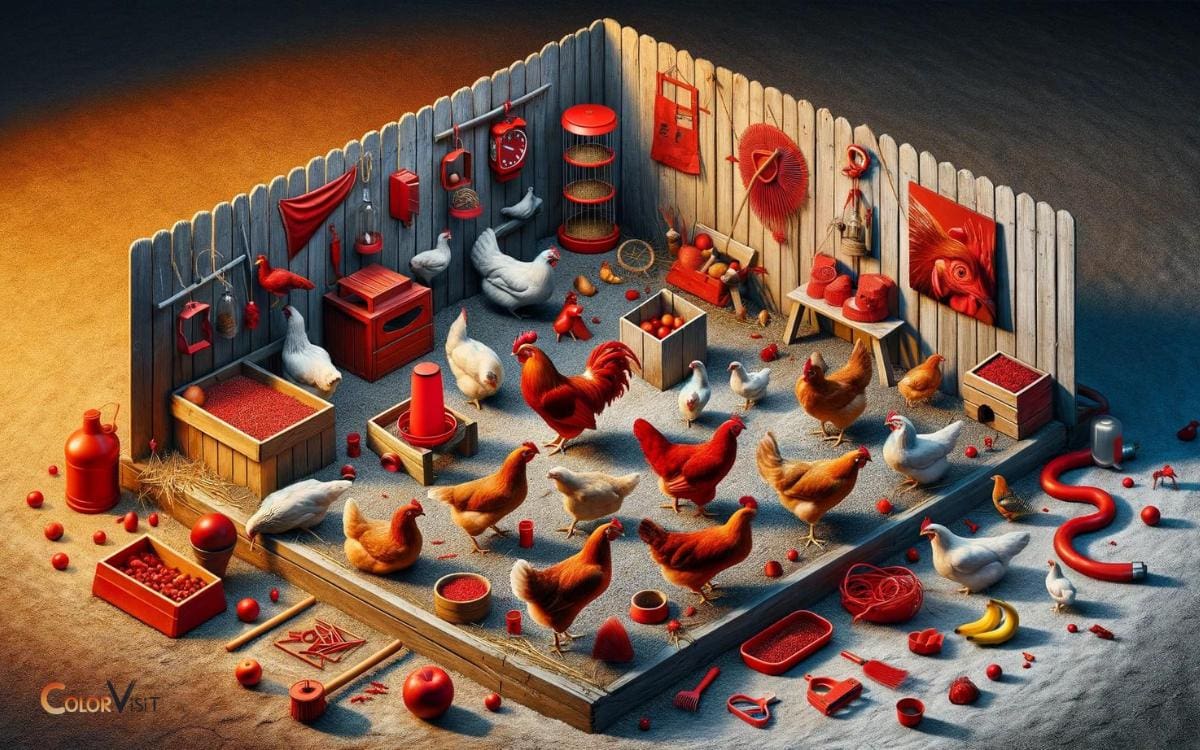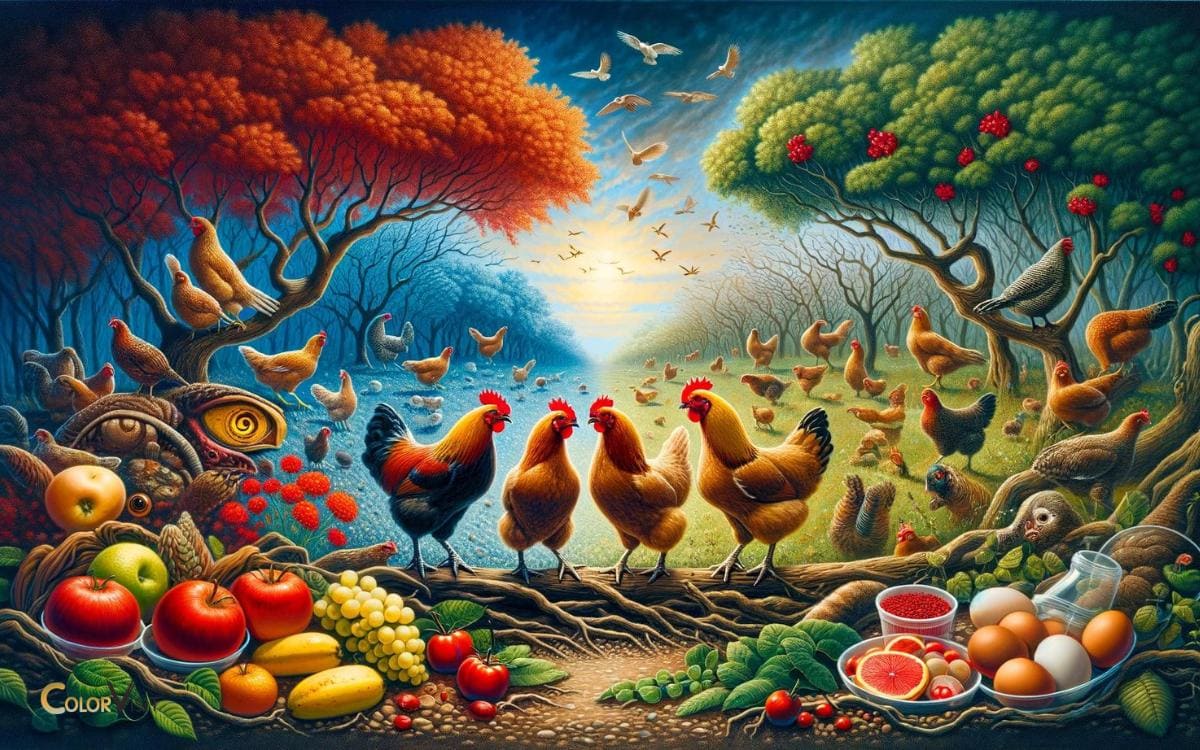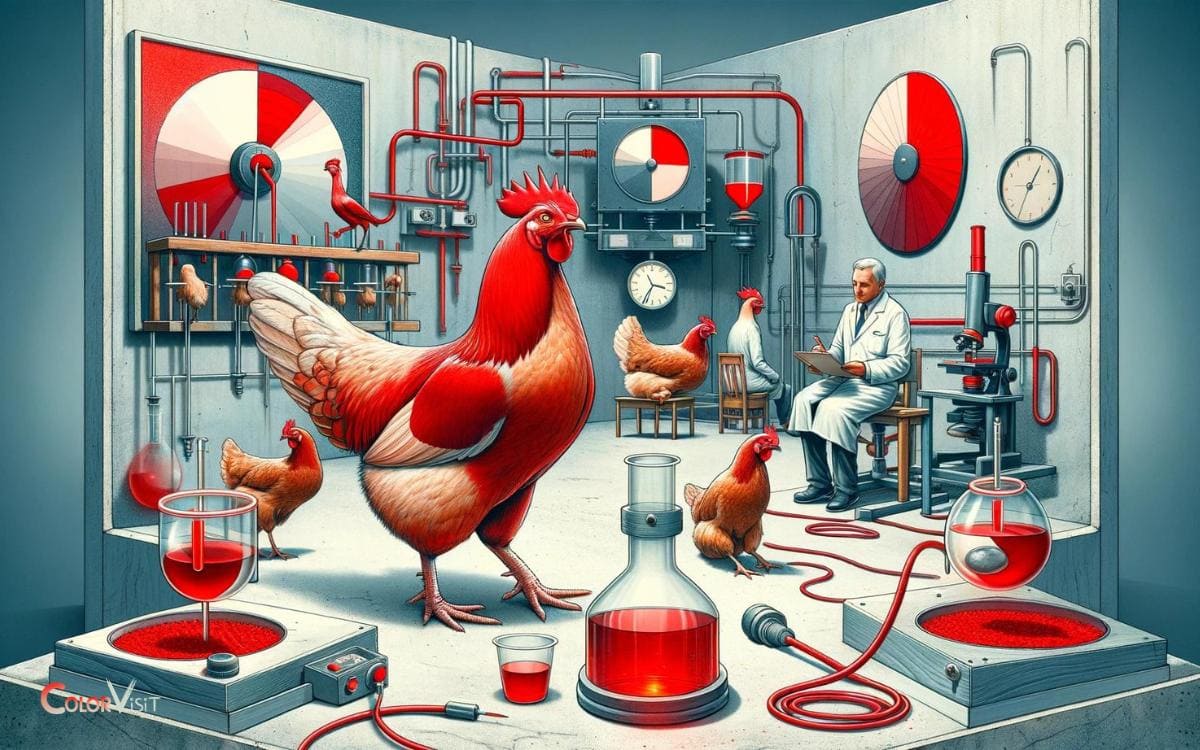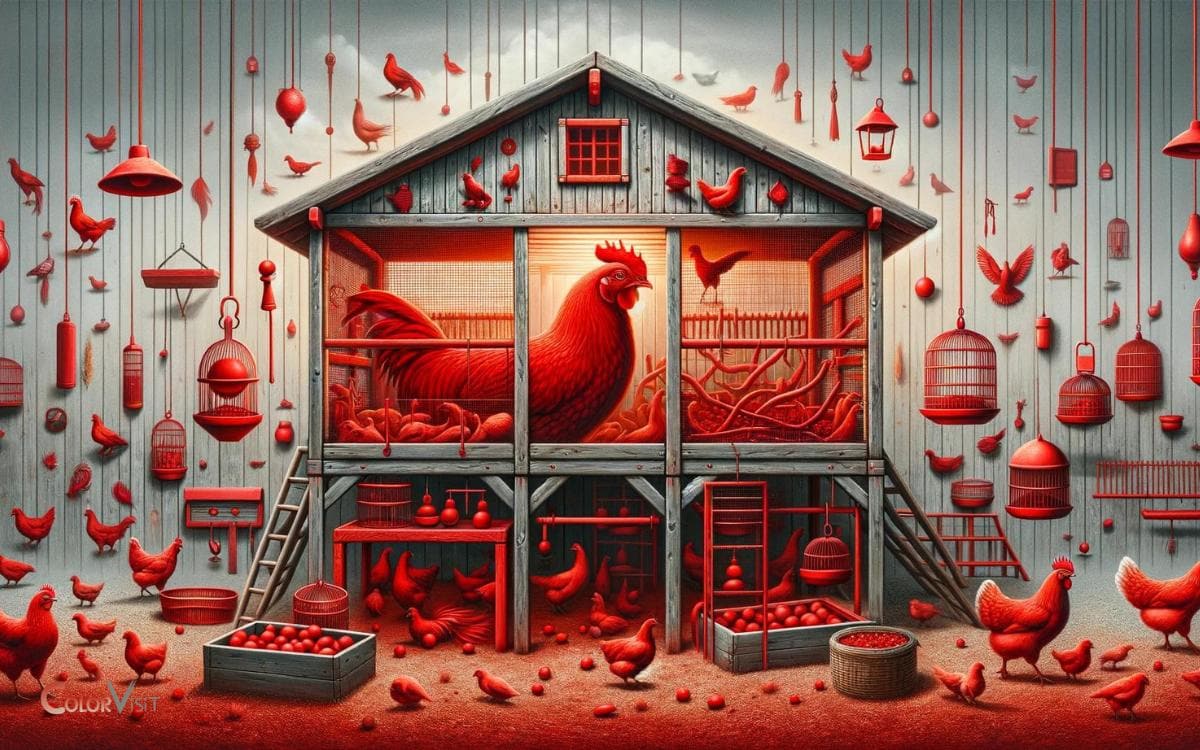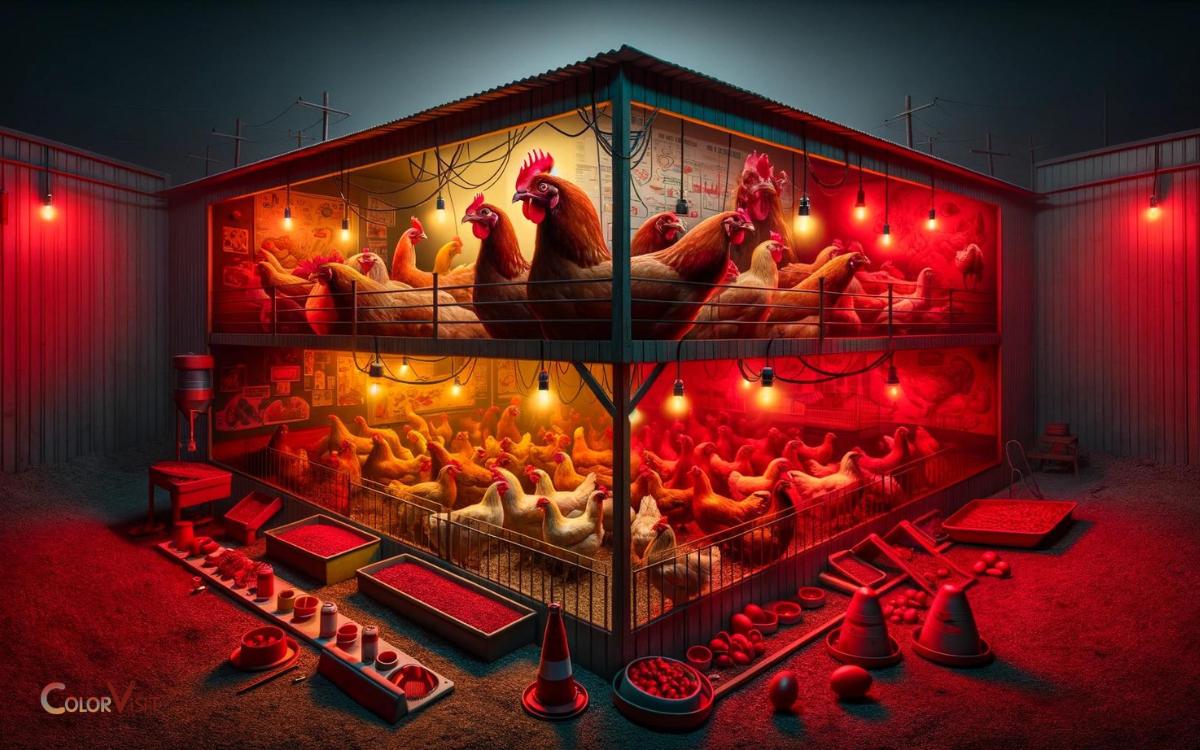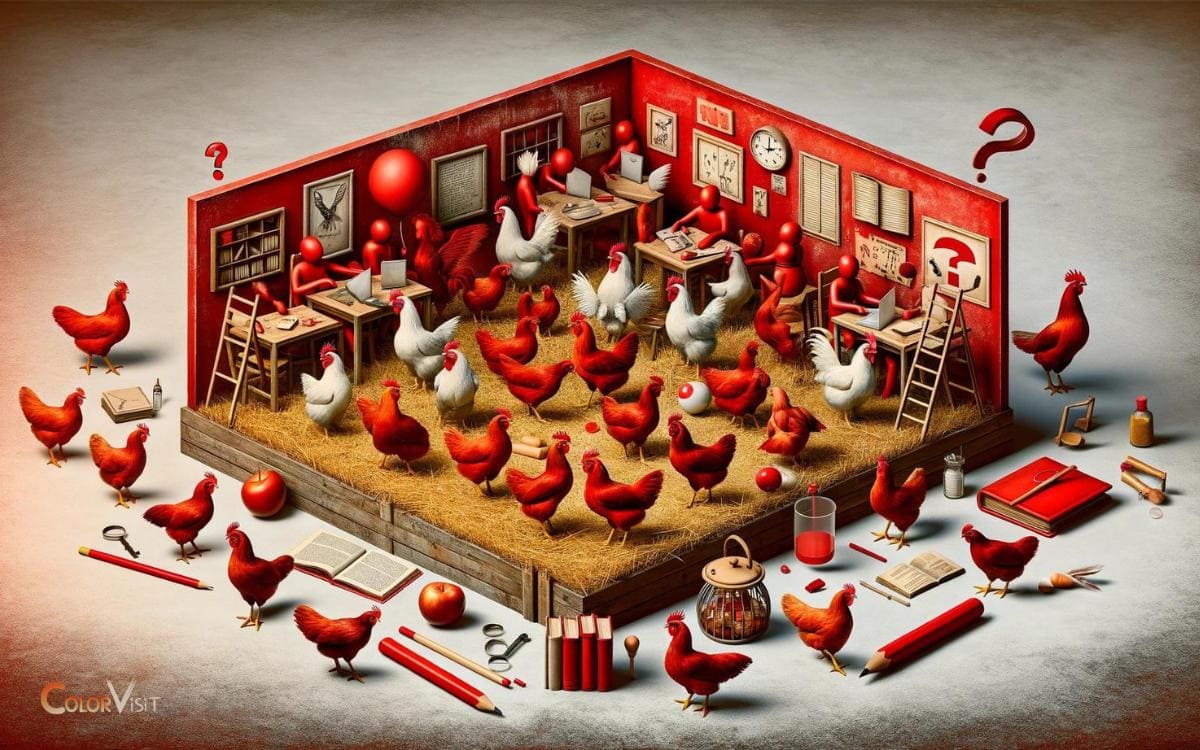Do Chickens Like the Color Red? Yes!
Yes, chickens are attracted to the color red. This is due to their complex eye structure that allows them to see a broad spectrum of color.
Chickens’ preference for red has been observed by both researchers and chicken keepers. Their attraction to red can be attributed to evolutionary factors and has practical applications.
For example, red drinkers and feeders are often used in poultry farms because chickens are more likely to peck at red objects, thereby encouraging them to eat and drink more.
In a nutshell, the color red plays a significant role in the behavior and welfare of chickens, making it a topic of interest for researchers and chicken enthusiasts alike.
Key Takeaway
The Color Red and Chicken Behavior
One study found that chickens are more attracted to the color red than to other colors, suggesting that it may have an impact on their behavior. This preference for red has led to innovative uses of the color in chicken farming.
- For instance, red lights have been used in poultry houses to reduce aggressive behavior and cannibalism among the birds.
- The color red has also been utilized in the design of feeding and drinking systems to attract chickens and encourage regular feeding and hydration.
- Understanding the impact of color on chicken behavior has opened up new possibilities for improving welfare and productivity in poultry farming.
As researchers continue to explore the relationship between color and animal behavior, the potential for innovative applications in agriculture and animal husbandry is vast.
Evolutionary Perspective on Red Preference
As we consider the evolutionary perspective on red preference in chickens, it is essential to examine how their vision and perception of red have evolved over time.
Additionally, delving into the role of red as a signal for food sources and its potential influence on foraging behavior can provide valuable insights.
Chicken Red Vision
The evolutionary development of chicken red vision influences their preference for the color red.
Chickens, like many birds, have tetrachromatic vision, enabling them to perceive a broader spectrum of colors than humans.
This evolutionary trait has shaped their behavior and preferences, particularly regarding the color red.
From an evolutionary perspective, the following factors contribute to chickens’ red preference:
- Enhanced detection of ripe fruits and berries
- Recognition of potential mates displaying red coloration
- Identification of predators or danger signals
These factors suggest that the preference for red in chickens is a product of their evolutionary history and has implications for various aspects of their behavior and survival.
Understanding these preferences provides valuable insights into the cognitive and perceptual abilities of chickens.
Red as Food
The evolutionary preference for the color red in chickens extends to their foraging and feeding behaviors, particularly in their attraction to red-colored food sources.
- This preference can be traced back to their wild ancestors, who relied on visual cues to identify ripe fruits, berries, and insects rich in nutrients.
- Red pigmentation is often associated with high levels of carotenoids, which are beneficial for avian health and reproduction.
- As a result, chickens have developed a natural inclination towards red-colored food, as it signifies a potential source of essential nutrients.
- This evolutionary adaptation has implications for poultry management and welfare, as it suggests that incorporating red pigments into their diet may enhance their feeding behavior and overall health.
Understanding this preference can also inform the development of innovative feeding strategies to optimize chicken nutrition and well-being.
Predator Avoidance Behavior
Chickens’ evolutionary preference for the color red also influences their predator avoidance behavior, shaping their response to potential threats in their environment.
This preference is rooted in their evolutionary history, where the color red signified ripe fruits and nutritious food sources.
From an evolutionary perspective, chickens’ predator avoidance behavior can be linked to their preference for the color red.
This is due to the following reasons:
- Camouflage: Red-colored predators may be more easily spotted against green foliage.
- Warning Signs: In nature, red is often associated with warning signs, such as poisonous berries or dangerous animals.
- Sexual Signaling: Red is also linked to mating behavior, and chickens may have developed an aversion to potential predators displaying this color.
These factors contribute to the evolutionary significance of chickens’ preference for the color red in their predator avoidance behavior.
Scientific Studies on Chickens and Red
Numerous scientific studies have been conducted to understand the relationship between chickens and the color red.
Researchers have investigated how red affects chicken behavior, the impact of red on their well-being, and the nuances of chicken vision and perception of the color red.
These studies provide valuable insights into the specific ways in which chickens interact with and respond to the color red, shedding light on the intricate dynamics at play in their environment.
Red and Chicken Behavior
When studying the behavior of chickens, scientific research has revealed a notable response to the color red.
Chickens have shown specific behavioral reactions to the color red, which has led to intriguing insights into their behavior.
Researchers have found that:
- Chickens are attracted to the color red due to its association with food and the perception of it as a food source.
- Red light has been observed to reduce aggressive behavior in chickens, promoting a calmer and more harmonious environment within poultry facilities.
- The presence of red objects or lighting can stimulate egg production in hens, potentially leading to increased productivity in commercial settings.
This understanding of the impact of red on chicken behavior has significant implications for poultry farming and animal welfare practices.
Impact of Red
The impact of red on the behavior and well-being of chickens has been extensively studied in scientific research, revealing significant implications for poultry farming and animal welfare practices.
- Studies have shown that exposure to red light can positively influence the behavior, welfare, and productivity of chickens.
- For example, red light has been found to reduce aggressive behaviors, improve feeding and drinking patterns, and enhance reproductive performance in laying hens.
- Furthermore, the use of red lighting in poultry housing has been linked to lower fear responses and improved overall welfare.
- These findings have led to the implementation of red lighting strategies in commercial poultry production to optimize chicken welfare and productivity.
As research in this area continues to advance, innovative applications of red lighting may further enhance the well-being of chickens in agricultural settings.
Chicken Vision and Red
According to scientific studies, red light has a significant impact on chicken vision and behavior. Research indicates that chickens perceive red light differently than humans.
- One finding is that red light has a calming effect on chickens, reducing stress and aggressive behaviors.
- This suggests that the color of light can influence chicken emotions and overall well-being.
- Another important discovery is that chickens are more sensitive to red light compared to other colors. Red light can affect their circadian rhythm, which regulates their sleep-wake cycle, and also their egg production.
- This implies that manipulating the lighting conditions, specifically using red light, can potentially optimize chicken behavior and productivity.
- Furthermore, red light can be utilized to manipulate chicken behavior in specific ways.
- For instance, it has been found that red light can stimulate feeding and reduce pecking, which are crucial factors in poultry farming.
Understanding the relationship between chicken vision and red light is of utmost importance for creating innovative lighting solutions that enhance animal welfare and optimize poultry production.
Red in Chicken Coops and Environments
Considering the impact of red in chicken coops and environments is essential for understanding its potential influence on the behavior and well-being of poultry.
- Red lighting has been found to reduce aggressive behavior among chickens, leading to a calmer and more content flock.
- Furthermore, red light has been shown to promote higher egg production, as it doesn’t disrupt the natural circadian rhythm of the chickens.
- In terms of environmental enrichment, red objects or structures within the coop can provide visual stimulation for the chickens, reducing boredom and encouraging natural foraging behaviors.
- It’s important to note that while red can have positive effects on chicken behavior, it should be used in moderation and in conjunction with other environmental enrichments to ensure the overall well-being of the flock.
Understanding the role of red in chicken coops and environments can lead to innovative approaches in poultry management.
Impact of Red on Chicken Welfare
Red’s impact on chicken welfare is an important consideration in managing poultry environments and behaviors.
Research suggests that the color red can significantly influence the well-being of chickens, impacting various aspects of their welfare.
- Red light has been found to reduce aggressive behaviors among chickens, creating a more harmonious and stress-free environment.
- The use of red lighting can also promote natural biological rhythms, leading to better sleep patterns and overall improved welfare for the birds.
- Red color in the environment can help to minimize fear and stress in chickens, leading to healthier and more content flocks.
Understanding the impact of red on chicken welfare can lead to innovative approaches in poultry management, ultimately contributing to higher levels of welfare and productivity in poultry farming.
Debunking Myths About Chickens and Red
Several studies have debunked the myth that chickens are inherently attracted to the color red.
While it was once widely believed that chickens were naturally drawn to the color red, recent research has provided evidence to the contrary.
Here are some key points to consider when debunking myths about chickens and the color red:
- Color Preference: Chickens do not have an innate preference for the color red, as they are capable of seeing a wide range of colors.
- Behavioral Responses: Studies have shown that chickens do not exhibit specific behavioral responses to the color red compared to other colors.
- Environmental Factors: The attraction to red objects in the coop can be attributed to environmental conditioning rather than an inherent preference for the color red.
As our understanding of animal behavior and perception evolves, it’s important to reevaluate long-standing assumptions about poultry preferences.
Conclusion
Research suggests that chickens are attracted to the color red due to evolutionary factors and it can have a positive impact on their behavior and welfare.
Studies have shown that chickens exposed to red light exhibit reduced aggression and improved overall welfare.
Interestingly, a study found that chickens spent 20% more time in areas with red lighting compared to other colors, indicating a strong preference for this color.


